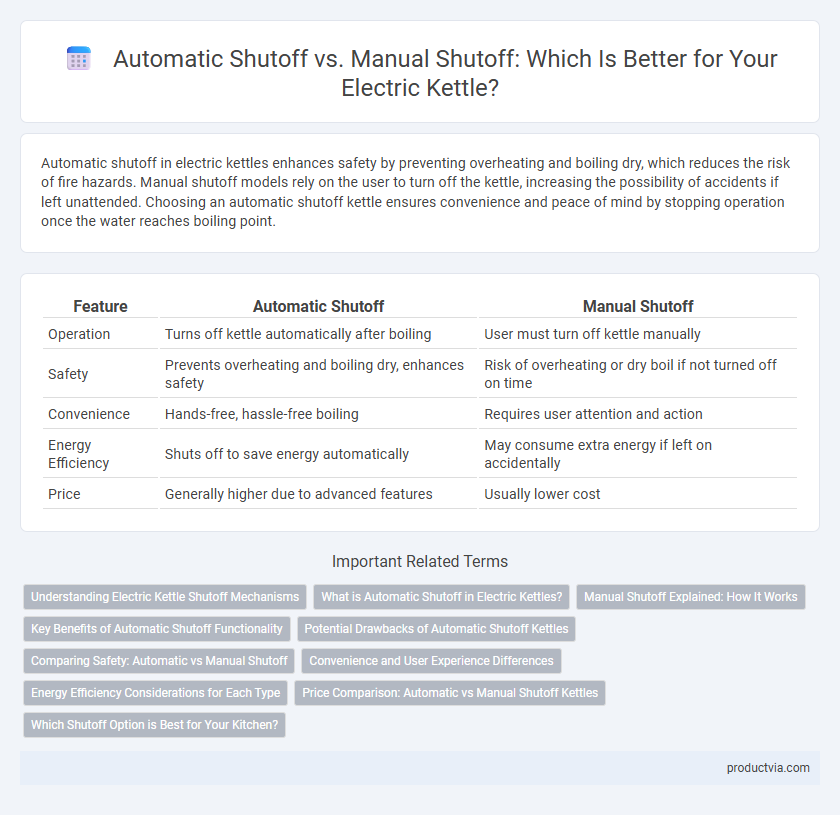Automatic shutoff in electric kettles enhances safety by preventing overheating and boiling dry, which reduces the risk of fire hazards. Manual shutoff models rely on the user to turn off the kettle, increasing the possibility of accidents if left unattended. Choosing an automatic shutoff kettle ensures convenience and peace of mind by stopping operation once the water reaches boiling point.
Table of Comparison
| Feature | Automatic Shutoff | Manual Shutoff |
|---|---|---|
| Operation | Turns off kettle automatically after boiling | User must turn off kettle manually |
| Safety | Prevents overheating and boiling dry, enhances safety | Risk of overheating or dry boil if not turned off on time |
| Convenience | Hands-free, hassle-free boiling | Requires user attention and action |
| Energy Efficiency | Shuts off to save energy automatically | May consume extra energy if left on accidentally |
| Price | Generally higher due to advanced features | Usually lower cost |
Understanding Electric Kettle Shutoff Mechanisms
Electric kettles feature two primary shutoff mechanisms: automatic and manual. Automatic shutoff utilizes a temperature sensor or thermostat to detect when water reaches boiling point, ensuring safety by preventing overheating and energy waste. Manual shutoff requires user intervention to turn off the kettle, offering more control but increasing the risk of boiling dry or accidental overheating.
What is Automatic Shutoff in Electric Kettles?
Automatic shutoff in electric kettles is a safety feature that turns the kettle off once the water reaches boiling point, preventing overheating and potential damage. This mechanism uses a thermostat or sensor to detect temperature changes and cut power instantly, ensuring energy efficiency and user protection. Unlike manual shutoff models, automatic shutoff provides convenience by eliminating the need for constant monitoring during boiling.
Manual Shutoff Explained: How It Works
Manual shutoff in electric kettles requires the user to physically turn off the device, typically by pressing a switch or lifting a lever once the water reaches the desired temperature. This method relies on user attention to prevent overheating or boiling dry, as the kettle will continue heating until manually stopped. Unlike automatic shutoff, manual shutoff offers control but demands active monitoring for safety and energy efficiency.
Key Benefits of Automatic Shutoff Functionality
Automatic shutoff in electric kettles enhances safety by preventing overheating and potential fire hazards, providing peace of mind during unattended boiling. This feature also improves energy efficiency by stopping power consumption once water reaches the boiling point, reducing electricity costs. Convenience is increased as users no longer need to monitor the kettle constantly, allowing for multitasking without compromising safety or performance.
Potential Drawbacks of Automatic Shutoff Kettles
Automatic shutoff electric kettles risk premature power cutoff if sensors misread steam or temperature, leading to incomplete boiling and energy inefficiency. Faulty sensors may also cause repeated cycling, reducing appliance lifespan and necessitating costly repairs. In contrast, manual shutoff models offer user control, minimizing shutdown errors but requiring constant supervision during use.
Comparing Safety: Automatic vs Manual Shutoff
Automatic shutoff electric kettles enhance safety by preventing overheating or boiling dry through built-in sensors that turn the device off once water reaches boiling point, significantly reducing fire hazards. Manual shutoff kettles rely on user intervention, increasing the risk of accidents due to forgetfulness or distractions, which can lead to overheating and potential damage. Consumer safety ratings and fire incident reports consistently favor automatic shutoff kettles for their reliable prevention of common electrical hazards.
Convenience and User Experience Differences
Automatic shutoff in electric kettles enhances convenience by eliminating the need for constant supervision, preventing overheating and potential hazards with precise temperature control sensors. Manual shutoff models require users to monitor the boiling process and turn the kettle off themselves, which may lead to occasional overboiling or dryness but offers greater control for custom heating preferences. The user experience with automatic shutoff is generally more seamless and safer, while manual shutoff gives a tactile interaction but demands more attention and care.
Energy Efficiency Considerations for Each Type
Automatic shutoff electric kettles enhance energy efficiency by preventing overheating and unnecessary power consumption once the water reaches boiling point. Manual shutoff models risk wasting energy if not turned off promptly, as they continue heating indefinitely. Choosing an automatic shutoff kettle optimizes electricity use and reduces energy bills through precise temperature control.
Price Comparison: Automatic vs Manual Shutoff Kettles
Automatic shutoff electric kettles typically cost between $20 and $60, offering enhanced safety and convenience by preventing overheating and boiling dry. Manual shutoff kettles are generally more affordable, ranging from $10 to $30, but require constant monitoring to avoid accidents. Investing in an automatic shutoff kettle can reduce long-term risks, justifying the higher initial price for frequent users.
Which Shutoff Option is Best for Your Kitchen?
Automatic shutoff electric kettles offer enhanced safety by preventing overheating and boiling dry, making them ideal for busy kitchens or households with children. Manual shutoff kettles provide greater control over the boiling process, preferred by tea enthusiasts who require precise timing for different brews. Choosing the best shutoff option depends on your priority between safety convenience and adjustable brewing control in your kitchen.
Automatic shutoff vs manual shutoff for electric kettle Infographic

 productvia.com
productvia.com